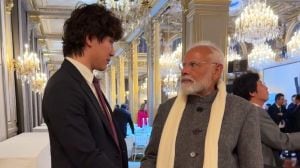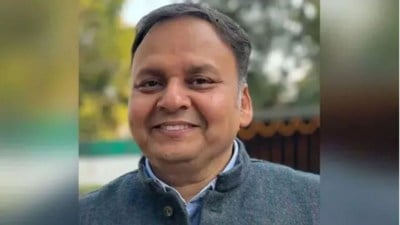Anjali Mehta has been working on a new illustration in the past few weeks to understand personal meaning and experience during the coronavirus pandemic through art. An illustrator based in New Delhi, Mehta’s work shows an elderly couple, who has been helped by a neighbour to get food and groceries, on a video call with their son in a different country.
The artwork, interestingly, is based on a famous Korean proverb, “The near neighbour is better than the distant relative.” “The beautiful part of this proverb is that it wasn’t just an experience in Korea, but all over—we have heard similar stories and seen videos of neighbours from all around the world,” says Mehta, whose past works celebrate human psychology and the marks people leave on the world.
Distance and proximity
Part of the Proximity and Distance art project of the Goethe Institute, India, to understand the behavioural changes in people brought about by the pandemic, Mehta’s illustration inspired by the Korean proverb and works of other artists address the challenges facing a pandemic-hit society. The project, which relies heavily on voices from the street, brings together artists from India, Germany, South Korea and Brazil.
Another Indian illustrator, Bangalore-based Srishti Guptaroy, focuses on the modern Indian family in her works for the Goethe Institute project. Guptaroy’s drawings, in which children are confined to home because of closed schools and colleges, explore whether physical proximity guarantees closeness in relationships. “All the artworks have a strong social commentary about the lives we live in 2021, but without being preachy,” adds the artist, a graduate of the National Institute of Fashion Design, New Delhi.
“We found distance and proximity to be one such fundamental parameter that enables us to understand the Covid-19 experience, not just in one country, but across the globe,” says Goethe Institute regional director South Asia, Berthold Franke. “Art has always been important, but it is only one form of an answer to any situation. At the same time, it is not fair to consider only voices from science and politics because then we miss out on the imaginative potential of art,” he adds.
The artistic and cultural evaluation of changes in societies following the pandemic also extend to learning lessons. “Pandemic is a regular character in human histories such as the black plague or Spanish flu, but the main difference today is that we are dealing with the same character in a new environment, where there is less delay in information, but an enormous force of disinformation to comprise the scenario,” explains Brazilian visual artist and educator Rosana Paulino.
Art and aftermath
Learning lessons was one vital element during the Covid-19 experience in South Korea. “Korea failed to respond to MERS (Middle Eastern Respiratory Syndrome that originated in Saudi Arabia in 2012),” says Kwang Sun Joo, who teaches ancient Western philosophy and intercultural philosophy at the Pusan National University. “From that, we learned a lesson that we must respond quickly and strongly to infectious diseases such as coronavirus. So Korea was able to respond well in the early stages,” adds Prof Kwang, one of the four experts on the Distance and Proximity project.
The month-long project, which opened on October 20, addresses the changes brought about by the pandemic through pop-up installations, illustrations, proverbs and paintings. “Covid-19, as a phenomenon, is absolutely new and has never been seen in the world before. Epidemics such as plague, cholera were known to mankind, but this pandemic is ‘new’ in that it affects the whole world and thus, overcomes distances in no time at all,” says Franke, Goethe Institute regional director, underlining the relevance of art in addressing the aftermath of the pandemic.
According to Indian writer-filmmaker Paromita Vohra, societies have responded in different ways in the aftermath of the health emergency. “I think we saw that societies like ours (India), which are deeply stratified, left large numbers of people vulnerable. We also saw that societies that were more prosperous, while addressing the concerns of their citizens, were participants in a deeply stratified world order,” she adds.
“We saw that technology—travel, trade, etc—have contributed to the swiftness of the pandemic, but also that it helped us survive through the hardships of lockdown, with some sense of connection. We also saw that in societies with deeply rooted family and community cultures, like India, there were citizens’ initiatives, religious and community group kitchens or oxygen services that filled the gap of a failing system,” says Vohra, who represents India on the project.
Faizal Khan is a freelancer








